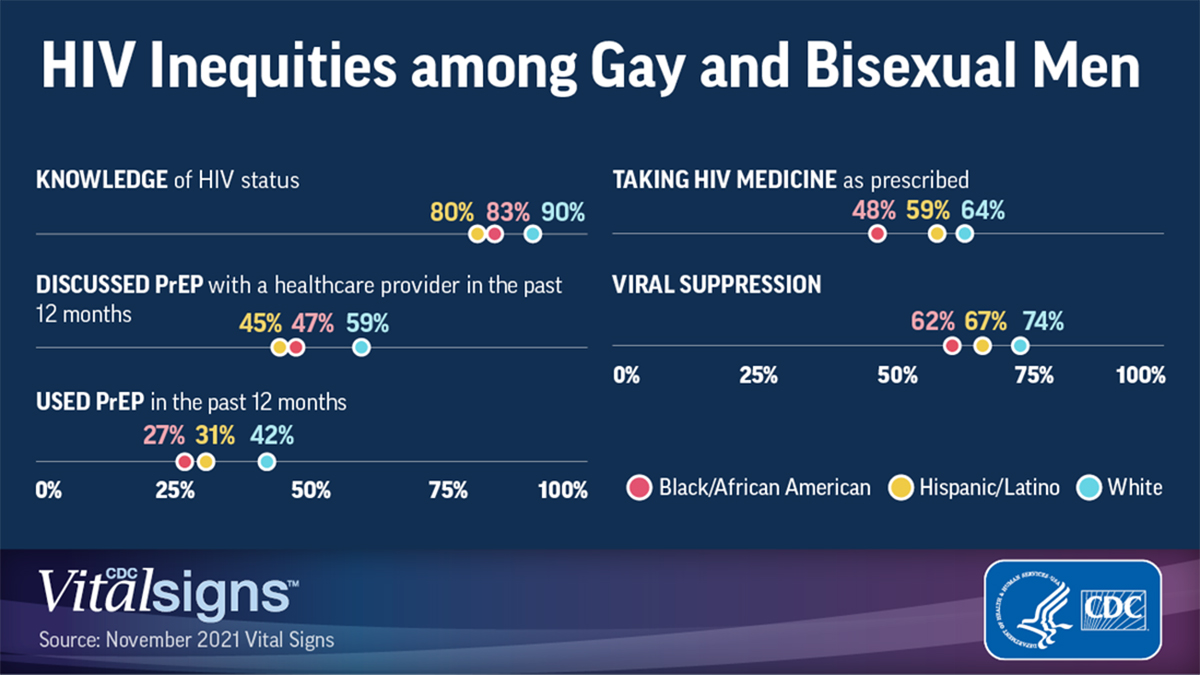New CDC Vital Signs Report Reveals a Decade of Continuing HIV Inequities on Eve of World AIDS Day
New infections dropped among White gay and bisexual men, but stayed flat among Black and Hispanic/Latino gay and bisexual men
Embargoed until: Tuesday, November 30, 2021, 1:30 PM ET
Contact: Media Relations
(404) 639-3286
Despite overall progress in reducing new infections among gay and bisexual men, the HIV epidemic continued and was more severe among Black or African American (hereafter referred to as Black) and Hispanic/Latino gay and bisexual men in the decade leading up to the federal Ending the HIV Epidemic in the U.S. (EHE) initiative, which the U.S. Department of Health and Human Services launched in 2019.
- From 2010–2019, the number of new HIV infections remained relatively stable among Black (from 9,000 to 8,900) and Hispanic/Latino (from 6,800 to 7,900) gay and bisexual men and declined among White gay and bisexual men (from 7,500 to 5,100).
Unequal reach of HIV prevention and treatment, higher levels of HIV in some communities, and systemic inequities fuel these troubling trends.
- The new Vital Signs report, which marks World AIDS Day tomorrow, December 1, shows Black and Hispanic/Latino gay and bisexual men were less likely to receive an HIV diagnosis, be virally suppressed, or use pre-exposure prophylaxis (PrEP) to prevent HIV, compared with White gay and bisexual men. In 2019:
- An estimated 83% of Black and 80% of Hispanic/Latino gay and bisexual men with HIV had been diagnosed, compared with 90% of White gay and bisexual men.
- An estimated 62% of Black and 67% of Hispanic/Latino gay and bisexual men with diagnosed HIV were virally suppressed, compared with 74% of White gay and bisexual men.
- The report also includes the most recent data on PrEP use among gay and bisexual men from 2017 showing that just 27% of Black and 31% of Hispanic/Latino men were using PrEP, compared with 42% of White men. While not nationally representative, the PrEP use data were collected from gay and bisexual men in 23 cities, where more than half of all people with HIV in large urban areas reside.
HIV-related stigma—negative attitudes and beliefs about people with HIV—may also contribute to these disparities. In an analysis of data from the Medical Monitoring Project—a nationally representative survey of people diagnosed with HIV—Black and Hispanic/Latino gay and bisexual men were more likely to report experiencing HIV-related stigma than White gay and bisexual men.
- Researchers assessed experiences of HIV-related stigma based on each participant’s degree of reported agreement or disagreement with 10 statements expressing different aspects of HIV stigma. On each question the score ranged from 0 to 10, for a total summed score from 0 (no reported stigma) to 100 (highest level of reported stigma). The median score for Black and Hispanic/Latino gay and bisexual men was 33 and 31, respectively, compared with 26 for White gay and bisexual men.
With effective prevention and treatment tools at our disposal, the nation has a decades-in-the-making opportunity to end the domestic HIV epidemic and erase glaring disparities in HIV prevention and care. CDC is working with partners through the federal Ending the HIV Epidemic in the U.S. initiative to scale up key, science-based HIV treatment and prevention strategies in innovative ways that reach populations equitably. The goal is to reduce HIV infections by 90% by 2030.

Table showing the percentages of White, Black/African American, and Hispanic/Latino gay and bisexual men who knew their HIV status, discussed PreP with a healthcare provider in the past 12 months, used PrEP in the past 12 months, took HIV medicine as prescribed, and were virally suppressed.
KNOWLEDGE of HIV status
Hispanic Latino – 80%
Black/African American – 83%
White – 90%
DISCUSSED PrEP with a healthcare provider in the past 12 months
Hispanic/Latino – 45%
Black/African American – 47%
White – 59%
USED PrEP in the past 12 months
Hispanic/Latino – 31%
Black/African American – 27%
White – 42%
TAKING HIV MEDICINE as prescribed
Hispanic/Latino – 48%
Black/African American – 59%
White – 64%
VIRAL SUPPRESSION
Hispanic/Latino – 62%
Black/African American – 67%
White – 74%
Throughout my career, I have witnessed a transformation for those living with and at risk for HIV,” said CDC Director Rochelle P. Walensky, M.D., M.P.H. “We have the scientific tools to end the HIV epidemic, however, to achieve this end we must acknowledge that inequities in access to care continue to exist and are an injustice. We must address the root causes of these ongoing disparities and make proven HIV prevention and treatment intervention available to all.
What can be done to address these inequities as we observe World AIDS Day?
- The nation must get to the ROOT of the problem, which means:
- Resources to the communities most in need—because currently not all can implement the most recent advances in HIV prevention and care
- Outside traditional health care—using innovations like self-testing and mobile services to reach people where they are
- Overcoming systemic racism, homophobia, stigma, and other barriers contributing to disparities
- Total person approach that addresses HIV along with interconnected epidemics and integrates prevention and treatment into services they are already seeking
Go to CDC.gov/VitalSigns for more information on the report, HIV.gov for more about the federal Ending the HIV Epidemic in the U.S. initiative, and CDC.gov/endHIV for more about CDC’s role.
###
U.S. DEPARTMENT OF HEALTH AND HUMAN SERVICES
CDC works 24/7 protecting America’s health, safety and security. Whether disease start at home or abroad, are curable or preventable, chronic or acute, or from human activity or deliberate attack, CDC responds to America’s most pressing health threats. CDC is headquartered in Atlanta and has experts located throughout the United States and the world.
